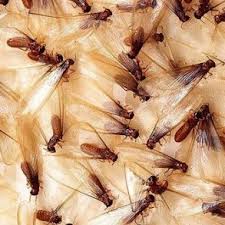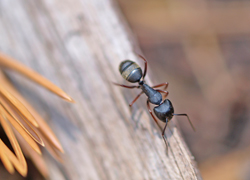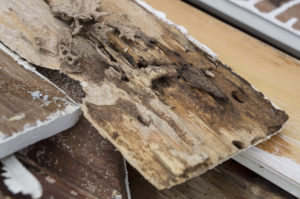When you first spot a few insects flying or crawling throughout your home, you may think nothing of it – until you notice signs of damage from these tiny unidentified pests. At the first signs of damage, you may immediately think you have a termite infestation due to their reputation for inflicting damage. However, you can’t always assume that the small insects you’re seeing are termites. In fact, you could be dealing with carpenter ants. Whether it’s termites or carpenter ants, neither pest infestation is ideal. Whichever it is, you’ll want these pests promptly exterminated from your home, as they can both cause severe (and costly) damage. Knowing the difference in appearance, behavior, and signs of carpenter ants vs. termites can help you spot these pests faster and act accordingly to rid them from your home.
The Difference in Appearance of Carpenter Ants and Termites

If you can get a closer look, you’ll be able to spot the difference between carpenter ants and termites just by their appearance. When comparing carpenter ants vs. termites, you’ll want to look for the following key identifying features. If you can get a good look, you may be able to determine if carpenter ants or termites are at the route of the infestation.
Color
When comparing carpenter ants vs. termites, their color, particularly of their wings, is a good way to spot the difference. Carpenter ants with wings (known as swarmers) are black or brown in color, often with a reddish tint to them. In addition, they have reddish-brown wings. On the other hand, termites with wings (also known as swarmers) typically have brown bodies with milky or smoky wings.
Size
Another key identifying factor when comparing carpenter ants vs. termites is size. Carpenter ants generally measure ½ inch to 1 inch in length. On the other hand, termites are smaller, usually no more than ½ inch long.
Body
When trying to determine the difference between carpenter ants and termites, take a look at the abdomen region. A carpenter ant, like other types of ants, will have a “waist”, with apparent narrowing in the center. In contrast, a termite will have no “waist”, maintaining the same width throughout the length of its body.
Antennae
As for these pests’ antennas, you’ll notice that on a carpenter ant, the antennas are bent at a 45 degree angle and have a segmented design. On the other hand, termites have straight antennas that have a beaded design.
Wings
Perhaps the clearest difference in appearance of carpenter ants vs. termites is their wings. Termites often have wings that are much longer than the body itself, overlapped and uniform in size. On the other hand, ant wings vary in length, with their hind wings typically smaller than the larger forewings.
Signs of Carpenter Ants vs. Termites
One of the key differences between carpenter ants and termites is how they cause damage within your home. Because of these differences, the signs of infestation between these two pests vary (along with the type of termite). Knowing the signs of carpenter ants vs. termites can help you to identify which pest is causing damage, allowing you to take appropriate action.
Seasonal conditions trigger both of these insect groups to seek out wood, particularly for its warmth and moisture. While both species cause damage once they find their way into your home, the type and degree of damage differs. In general, because wood has no nutritional value for carpenter ants, they make nests out of it and create tunnels in the process. On the flip side, termites consume the cellulose within the wood in order to survive. Because they behave differently within your home, the signs of an infestation for each pest differs. Here is how to tell the signs of carpenter ants vs. termites:
Signs of Carpenter Ants
- Piles of wood shavings found beneath wooden areas of your home, such as baseboards, window sills, and door jambs
- Faint rustling noises coming from within your walls and woodwork
- Spotting long ant paths or trails across your lawn
- Finding large winged ants within your home
Signs of Termites
- Drooping or discolored drywall
- Peeling paint
- Wood that sounds hollow when tapped
- Noticing floorboards that are suddenly squeaky or sagging
- Wood that is crumbling from damage
- Small pinpoint holes in drywall
- Piles of wings left by swarmers
- Mud tubes climbing your home’s foundation
- Maze-like patterns on walls, floor boards, or furniture
Carpenter Ant vs. Termite Droppings
Another sign of either of these pests is finding droppings throughout your home. Knowing the difference between carpenter ants vs. termite droppings can help you determine which pest is the cause of your home’s infestation.
Carpenter Ant Droppings: Droppings left behind by carpenter ants are soft and fibrous, made up of wood and fecal matter that is loosely packed. You’ll typically find these droppings near nesting sites, often in small openings within wood structures.
Termite Droppings: Knowing the difference between carpenter ant vs. termite droppings will not only help you determine which pest you are dealing with, but also what variety of these pests you’re dealing with. If you are noticing significant damage within the wooden structures of your home but no droppings, you are likely dealing with subterranean termites. These types of termites use their droppings as building material, thus leaving none for you to find. On the other hand, if the damage is accompanied by droppings that look like small grains of salt or pepper, you likely have a drywood termite infestation. In contrast to carpenter ants, these dropping are more tightly packed, consisting mostly of fecal matter.
Carpenter Ant Damage vs. Termite Damage
One of the biggest differences between carpenter ants and termites is the damage that they cause to your home. Knowing the difference between carpenter ant damage vs. termite damage can help you identify which pest is wreaking havoc on your home quickly and contact the right extermination professionals. So, here are the key characteristics of carpenter ant damage vs. termite damage.
Carpenter Ant Damage
- Carpenter ants build their nests in wooden structures found in moist and damp areas, often found in bathrooms, basements, and under the kitchen sink.
- Carpenter ant tunnels often look clean, polished and smooth, and will have holes for removing unwanted debris. Outside, you’ll notice piles of shavings called frass, plus dead insects. Also, the surface of the wood may show no signs of damage or may look sanded down.
- Carpenter ant damage is based on colonies and tends to be gradual, taking years to affect your home.
- The cost of repairing carpenter ant damage typically ranges anywhere from $250 to $500. However, repairs can reach into the thousands if the infestations took place over several years.
Termite Damage
- Termites feed on wood, having the ability to severely compromise the structural integrity of your home. They build their colonies within the walls and furniture in which they find this wood to feed on.
- Termite tunnels, often found in the yard, are less precise than those of carpenter ants, often containing soil and mud.
- Termite damage varies across species. Drywood termites, similar to carpenter ants, create frass and other debris, but you’ll find fecal pellets too, usually uniform in size and shape. On the other hand, subterranean termites go after softer spring wood and their damage often creates a layered effect.
- Termites cause significant damage to homes that can cost upwards of $3,000 to repair.
Knowing the difference between carpenter ants and termites is important for quick and easy identification. Determining if you have carpenter ants or termites in your home will allow you to act promptly and contact a professional pest exterminator for help. If you discover carpenter ants or termites in your home, contact Eliminate ‘Em for carpenter ant and termite extermination services. Our trusted termite and ant extermination professionals will help return peace to your home, keeping your family and home safe from pests. To make an appointment, contact us today.




